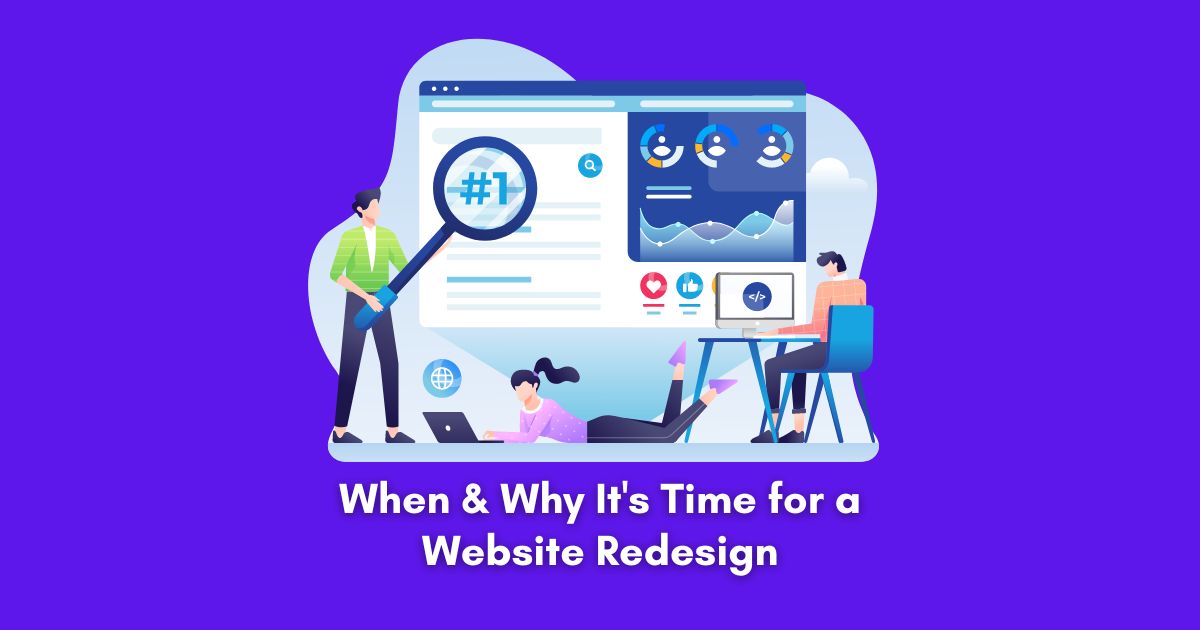A website is often the first point of contact between a business and its customers. It’s a vital tool for communication, marketing, and sales. A website represents your brand, tells your story, and provides a platform for customers to engage with your products or services.

As such, maintaining an up-to-date, functional, and aesthetically pleasing website is crucial. A website redesign involves overhauling the look, feel, and functionality of a website.
This process is essential for keeping up with technological advancements, design trends, and changing user expectations. Regularly updating your website ensures that it remains an effective tool for business growth and customer engagement.
The Impact of an Outdated Website
◉ Harm to Brand Perception
An outdated website can severely damage your brand’s image. In today’s digital age, customers expect modern, visually appealing, and easy-to-navigate websites. A web design that looks old-fashioned can make your business appear unprofessional and out of touch with current trends, leading to a loss of trust and credibility.
◉ Poor User Experience (UX)
User experience is crucial for retaining visitors and encouraging them to interact with your content. An outdated website often has slow load times, non-responsive design, and complicated navigation. These issues frustrate users, leading to high bounce rates as visitors quickly leave in search of a more user-friendly alternative.
◉ Negative Impact on Conversions
A dated design can directly affect your conversion rates. If your website is cluttered, has broken links, or outdated content, users may find it difficult to locate the information they need or complete transactions. This can result in lost sales and reduced engagement, ultimately harming your bottom line.
◉ Reduced SEO Performance
Search engines favor websites that provide a good user experience and relevant content. An outdated website may not meet current SEO standards, such as mobile-friendliness and fast loading times, resulting in lower search engine rankings. This reduces your visibility to potential customers and can significantly impact your organic traffic.
Signs Your Website Needs a Redesign
◉ Design and Functionality Issues
One of the most apparent signs that your website needs a redesign is outdated design and functionality. If your website looks like it belongs in the early 2000s, it’s time for a change. Modern design trends favor clean, minimalistic layouts with ample white space and high-quality images. Additionally, if your website is not responsive, meaning it doesn’t adjust seamlessly to different screen sizes, you are likely losing mobile users.
◉ Content-Related Issues
Content is king, but outdated or irrelevant content can quickly dethrone your website’s effectiveness. If your site’s content is not regularly updated, it can hurt your SEO rankings and make your business appear inactive. Furthermore, if your website’s messaging no longer aligns with your brand’s voice or current offerings, it can confuse and deter potential customers.
◉ Performance Issues
Performance issues, such as slow load times, broken links, and frequent downtime, are critical indicators that a redesign is necessary. Users expect websites to load within seconds, and any delay can lead to increased bounce rates. Regularly encountering errors or broken elements can frustrate users, causing them to lose trust in your site’s reliability.
Aligning Your Redesign with Business Goals
Before embarking on a website redesign, it’s crucial to define your website’s goals. A successful redesign should support your overall business objectives, whether that’s generating leads, increasing sales, improving brand awareness, or promoting customer service.
For example, if your primary goal is to generate leads, your redesigned website should feature clear calls to action, easy-to-find contact forms, and compelling landing pages. If increasing sales is your objective, ensure that the user journey from browsing to checkout is seamless and intuitive.
Planning and Executing Your Redesign
Planning and executing a website redesign involves several key steps. First, conduct thorough user research to understand your target audience’s needs and preferences. This will inform design and functionality decisions that enhance the user experience.
Next, collaborate with website development and design professionals as they will help you to apply needed web design solutions. Their expertise will ensure that your redesign is technically sound and visually appealing. Establish a clear timeline and budget to keep the project on track and within financial limits.
During the redesign process, regularly test new elements to ensure they meet user expectations and business objectives. Once the redesign is complete, launch the new site with a strategy for ongoing maintenance and content updates to keep it fresh and relevant.
Conclusion
A well-executed website redesign can significantly benefit your business by improving brand image, enhancing user experience, and increasing conversions. Regularly updating your website ensures that it remains an effective tool for engaging with customers and achieving business goals.
In addition to redesigning your website, it’s important to commit to ongoing maintenance and content updates. This will help you stay ahead of the competition and continue to meet the evolving needs of your audience. By investing in a website redesign, you are investing in the future success of your business.